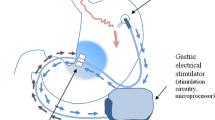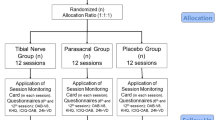Abstract
Background
The percutaneous electrical neurostimulation (PENS) of dermatome T6 has emerged as an effective treatment for appetite reduction and weight loss, allowing a better compliance of hypocaloric diets. The main drawback of this approach is the need of attendance to the sanitary institution weekly during 3 months.
Methods
A prospective, randomized study was performed. The patients were randomized into three groups: those undergoing conventional PENS of dermatome T6 associated with a 1200 kcal diet (group 1), those undergoing PENS of dermatome T6 with a self-applied patch associated with diet (group 2), and those following only a 1200 kcal diet (group 3).
Results
One hundred thirty-five patients were included in the study, 45 in each group, 51 males, and 81 females with a mean age of 54.5 years and BMI 35.9 kg/m2. The median pain perception in group 1 was 1 (range 0–2), while in group 2, it was 4 (range 2–7) (p = 0.024). Seven patients of group 2 abandoned the treatment because the self-application of the patch was painful. Excess weight loss was 32.7 % in group 1, 3.2 % in group 2, and 2.6 % in group 3 (p = 0.001). Appetite, as measured by VAS, decreased from 6 to 1.5 in group 1, while in the other groups remained similar (p = 0.001).
Conclusions
Conventional PENS of dermatome T6 is associated with an appetite reduction and, along with a proper diet, achieved a significantly greater weight reduction compared to diet alone in morbidly obese patients. PENS of dermatome T6 performed with a self-applied patch failed to demonstrate any effect on appetite and weight loss. Moreover, the self-application therapy was associated with a significantly greater pain, reducing the compliance of the therapy.




Similar content being viewed by others
References
Bray GA. Medical consequences of obesity. J Clin Endocrinol Metab. 2004;2583–9.
Ruiz-Tovar J, Oller I, Tomas A, et al. Midterm impact of sleeve gastrectomy, calibrated with a 50-Fr bougie, on weight loss, glucose homeostasis, lipid profiles, and comorbidities in morbidly obese patients. Am Surg. 2012;78:969–74.
Nguyen NT, Magno CP, Lane KT, et al. Association of hypertension, diabetes, dyslipidemia and metabolic syndrome with obesity: findings from the National Healcth and Nutrition Examination Survey 1999 to 2004. J Am Coll Surg. 2008;207:928–34.
Ruiz-Tovar J, Boix E, Bonete JM, et al. Effect of preoperative eating patterns and preoperative weight loss on the short- and mid-term weight loss results of sleeve gastrectomy. Cir Esp. 2015;93:241–7.
Chen J. Mechanisms of action of the implantable gastric stimulator for obesity. Obes Surg. 2004; 28–32.
Yao SK, Ke MY, Wang ZF, et al. Visceral response to acute retrograde gastric electrical stimulation in healthy human. World J Gastroenterol. 2005;11:4541–6.
Ruiz-Tovar J, Oller I, Diez M, et al. Percutaneous electrical neurostimulation of dermatome T6 for appetite reduction and weight loss in morbidly obese patients. Obes Surg. 2014;24:205–11.
Ruiz-Tovar J, Oller I, Llavero C. Pre-operative and early post-operative factors associated with surgical site infection after laparoscopic sleeve gastrectomy. Surg Infect (Larchmt). 2013;14:369–73.
Ruiz-Tovar J, Oller I, Galindo I, et al. Change in levels of C-reactive protein (CRP) and serum cortisol in morbidly obese patients after laparoscopic sleeve gastrectomy. Obes Surg. 2013;23:764–9.
Boyle DJ, Prosser K, Allison ME, et al. Percutaneous tibial nerve stimulation for the treatment of urge fecal incontinence. Dis Colon Rectum. 2010;53:432–7.
Pereira E, Foster A. Appetite suppression and weight loss incidental to spinal cord stimulation for pain relief. Obes Surg. 2007;17:1272–4.
Wang J, Song J, Hou X, et al. Effects of cutaneous gastric electrical stimulation on gastric emptying and postprandial satiety and fullness in lean and obese subjects. J Clin Gastroenterol. 2010;44:335–9.
Yin J, Ouyang H, Wang Z, et al. Cutaneous gastric electrical stimulation alters gastric motility in dogs: new option for gastric electrical stimulation? J Gastroenterol Hepatol. 2009;24:149–54.
Abell TL, Minocha A, Abidi N. Looking to the future: electrical stimulation for obesity. Am J Med Sci. 2006;331:226–32.
Vitton V, Damon H, Roman S, et al. Transcutaneous posterior tibial nerve stimulation for fecal incontinence in inflammatory bowel disease patients: a therapeutic option? Inflamm Bowel Dis. 2009;15:402–5.
Ruiz-Tovar J, Llavero C, Ortega I, et al. Percutaneous electric neurostimulation of dermatome T7 improves glycemic profile in obese and type 2 diabetic patients. A randomized clinical study. Cir Esp. 2015;93:460–5.
Author information
Authors and Affiliations
Corresponding author
Ethics declarations
Conflict of Interests
Mohammed Abdel-Kadar, MD, declares that he has no conflict of interests in the preparation of this manuscript.
Statement of Informed Consent
Informed consent was obtained from all individual participants included in the study.
Statement of Human Rights
All procedures performed in this study were in accordance with the ethical standards of the institutional research committee and with the 1964 Helsinki declaration and its later amendments.
Additional information
ClinicalTrials.gov Identifier: NCT02564627
Rights and permissions
About this article
Cite this article
Abdel-Kadar, M. Percutaneous Electrical Neurostimulation (PENS) of Dermatome T6 with an Ambulatory Self-applied Patch vs PENS of Dermatome T6 with Conventional Procedure: Effect on Appetite and Weight Loss in Moderately Obese Patients. OBES SURG 26, 2899–2905 (2016). https://doi.org/10.1007/s11695-016-2214-0
Published:
Issue Date:
DOI: https://doi.org/10.1007/s11695-016-2214-0




